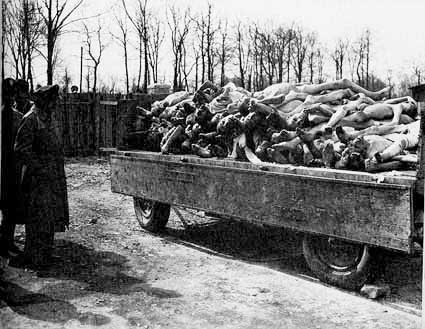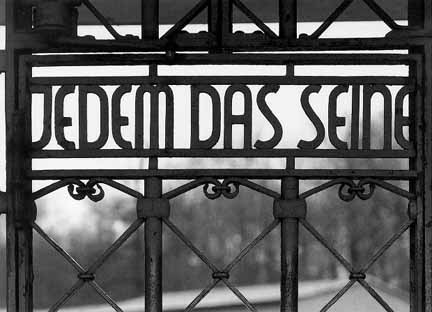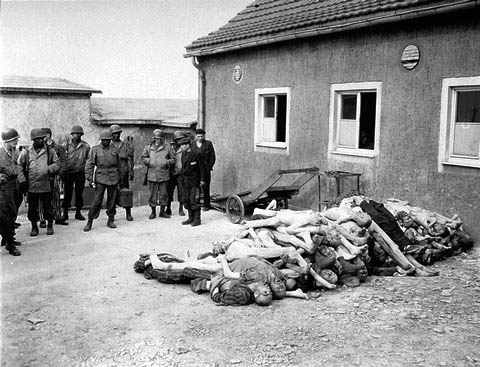Who really liberated the Buchenwald Camp? An American soldier named Harry J. Herder, Jr. claims that he was on the first American tank that broke down the barbed wire fence at Buchenwald and forced its way into the camp. The first soldiers who arrived at the Buchenwald camp on April 11, 1945 were with the 6th Armored Division of the US Third Army, but the camp had already been taken over by the prisoners a few hours earlier and it was not necessary to break down the fence surrounding the camp. Pfc. James Hoyt has been credited with driving the M8 armoured vehicle which brought Capt. Frederic Keffer, Tech. Sgt. Herbert Gottschalk and Sgt. Harry Ward to the Buchenwald camp that day. He parked the vehicle outside while Capt. Keffer and Sgt. Gottschalk went through a hole in the barbed wire fence that had been made by the prisoners. Herder described how the American soldiers looked the other way when the Communist inmates hunted down an escaped SS guard, brought him back to the camp and forced him to tie a noose to hang himself. The Communist prisoners did hunt down 76 guards and bring them back to the camp to be murdered by the inmates, but Herder's general description of Buchenwald has some suspicious details: Herder wrote in his story of the liberation that he rode into the camp on a tank after breaking down the barbed wire fence that was on the side of the camp opposite the gatehouse, and then drove "down hill" to the gate house. The gatehouse was at the top of the slope on which Buchenwald was built, so it was up hill from the fence on the opposite side. Herder mentioned that there was a "wooden beam" with the words "Arbeit Macht Frei" in German script over the gatehouse. Only Class I camps, such as Dachau and Sachsenhausen, had a sign with the words Arbeit Macht Frei. Buchenwald was a Class II camp and these words were nowhere to be seen. Buchenwald had the words "My country, right or wrong" written in German on the gatehouse and the German words "Jedem das Seine" written on the iron gate. The words "My country, right or wrong" have since been removed.  Herder wrote that the next day after the liberation, which would have been April 12th, a Life photographer came to take pictures. Margaret Bourke-White, the Life photographer who photographed Buchenwald, was traveling with the Third Army and she arrived on April 15th, along with General George S. Patton. Herder wrote, regarding the Life photographer: "He took a photograph...." Herder described the dead bodies "stacked like cord wood" outside the camp enclosure, apparently not knowing that the crematorium was located inside the Buchenwald camp, not outside, as at Dachau. The bodies found at Buchenwald were stacked near the crematorium or on trucks, not in piles outside the camp as Herder wrote. Herder described how the American soldiers gave chocolate to the young children in the camp; he wrote that one young boy had lived in the camp for years, never having the pleasure of tasting chocolate candy. Herder apparently didn't know that all the Nazi concentration camps received packages from the Red Cross which always contained chocolate. The prisoners were also allowed to receive packages from friends and relatives. A factory at the Buchenwald camp was hit by an Allied bomb on August 24, 1944 and a tree inside the camp was killed, although Herder wrote that the camp itself had not been hit. The tree stump was still there when the American liberators arrived. Herder wrote about visiting the medical building where human organs were stored in jars. These organs had been removed from condemned German criminals who had died during the medical experiments which were conducted at Buchenwald. Doctors at Buchenwald were doing experiments in an attempt to find a cure and a vaccine for typhus, but Herder wrote that Jewish prisoners had been chosen for experiments in which they were sprayed with water and left outside to freeze. Then an attempt was made to warm them up by placing two women on either side of them. This sounds like the experiments for the Luftwaffe which were done at Dachau, not Buchenwald. Lastly, Herder wrote that the mayor of Weimar and his wife had committed suicide after being forced to witness the atrocities at the Buchenwald camp. It was the mayor of the town of Ohrdruf who committed suicide, along with his wife, after General Walton Walker ordered the people of the town to visit a sub-camp of Buchenwald near Ohrdruf.  The American army was segregated during World War II, with white soldiers fighting in exclusively white divisions while black and Asian soldiers had their own separate divisions, commanded by white officers. The 183rd Engineer Combat Battalion was attached to the 1126th Engineer Combat Group in April 1945. On April 12, 1945, the 1126th Engineer Combat Group was sent to the town of Eisenach, around 100 kilometers from the Buchenwald concentration camp. Five days later, on April 17, 1945, several black soldiers were sent to Buchenwald to deliver some supplies. For most of the liberated prisoners, this was the first time they had ever seen a black man, and many of them would recall it later in their survivor accounts. By 1993, the story of the black troops at Buchenwald had escalated to an account of how African Americans had been the ones to actually liberate the Jews of Buchenwald. Even though there were only 4,000 Jewish prisoners among the 21,000 inmates still in the camp when the liberators arrived, the irony of the persecuted people of America freeing the persecuted people of Europe appealed to the Politically Correct generation. The records for the 183rd Engineer Combat Battalion are stored in the National Archives at Suitland, Maryland, filed under Record Group 407, Vol.33, ENBN-183 -0.##. Strangely, the unit records for April 1945 are missing. Because of this, William A. Scott III and Dr. Leon Bass can claim that they were sent to the Buchenwald concentration camp on April 12, 1945, not April 17th. The rules of the U.S. Army state that a liberator is a soldier who arrived at a concentration camp within 48 hours of the first soldier to enter the camp. If Scott and Bass arrived on the 12th, that means that they are officially considered liberators of Buchenwald. The following quote is from an article entitled "William A. Scott, III and the Holocaust: The Encounter of African American Liberators and Jewish Survivors at Buchenwald" by Asa R. Gordon, Executive Director Douglass Institute of Government (Dedicated to the Scott Family): In his pamphlet "World War II Veteran Remembers the Horror of the Holocaust," William A. Scott, III describes what happened when they arrived at Buchenwald. "We got out of our vehicles and some began to beckon to us to follow and see what had been done in that place - they were walking skeletons. The sights were beyond description. ... I had thought no place could be this bad. I took out my camera and began to take some photos - but that only lasted for a few pictures. As the scenes became more gruesome, I put my camera in its case and walked in a daze with the survivors, as we viewed all forms of dismemberment of the human body." Scott describes an incident that occurred after they entered Buchenwald which indicates how early they must have arrived at the concentration camp after its initial discovery. "An SS trooper had remained until the day of our arrival and survivors had captured him as he tried to flee over a fence. He was taken into a building where two men from my unit followed. They said he was trampled to death by the survivors." Scott expressed a sentiment that is shared by many veterans who were witness to these camps. "I began to realize why few, if any, persons would believe the atrocities I had seen. HOLOCAUST was the word used to describe it - but one has to witness it to even begin to believe it." Both Dr. Leon Bass and William A. Scott, III have been on the lecture circuit since 1968, telling their story of how black soldiers in the segregated U.S. Army "liberated" Buchenwald. Dr. Bass appeared in the Academy Award-nominated Documentary film entitled "Liberators: Fighting on Two Fronts in World War II," which claimed that black troops liberated not only Buchenwald, but also Dachau. Gunther Jacobs was a survivor of Buchenwald who had spent three and a half years in Nazi concentration camps. In an interview with Jeff Bradley of the Denver Post in 1989, Jacobs said: "The first Black people I ever saw in my life were the Black soldiers who liberated us on April 11, 1945." Jacobs told Bradley that he had never been able to speak out about what happened at Buchenwald, but he wanted to speak now "on behalf of his Black liberators" whom he had never thanked. In 1989, Henry Kamm visited the former Buchenwald camp and then wrote an article about it for the New York Times. He quoted Eli Wiesel, Buchenwald's most famous survivor, regarding the black liberators of Buchenwald. In a telephone interview, Wiesel told Kamm : "The most moving moment of my life was the day the Americans arrived, a few hours after the SS had fled. It was the morning of April 11...I will always remember with love a big Black soldier. He was crying like a child -- all the pain in the world and all the rage. Everyone who was there that day will forever feel a sentiment of gratitude to the American soldiers who liberated us." Gunther Jacobs and Elie Wiesel were both seventeen years old when Buchenwald was liberated. Jacobs told Kamm about the Black soldiers "coming to the camp with half-tracks and armored personal carriers. About a half dozen vehicles. These Black GIs came out and gazed at us -- we were very malnourished and dehydrated and I was hardly able to walk." The following is the story of the liberation of Buchenwald, as told by Dr. Robert M. Frank, who wrote this account in an e-mail to me on September 3, 2008: It is amazing how history can be written and re-written, although probably well-intended often misses the mark by the proverbial mile! This writer is now 83 years old. but
remembers only too well what happened at Buchenwald! 63+ years
ago, I was a 19 year old radio-operator in the 87th Infantry
Division - third Army! After the Battle of the Bulge - have a
long scar on the left thigh to remind me of same -- thanks to
an unfriendly German mortar shell -- we fought across central
Germany to meet the on-coming Russians some fifteen miles above
the Czech border on a line slightly east of Berlin. It was April 10, or was it April 11 or 12? Memory of this character -- at best is questionable. But the following is accurate: At first we were NOT permitted to write home about these events -- our letters were thoroughly censored by our officers -- until Eisenhower lifted all restrictions on April 16th -- I have the letters I wrote home to my family! Having written the above, I can aver
that the following is accurate: Robert M. Frank, M.D. -- ( the G.I.
Bill gave me a good medical education) Soldiers from the 87th Infantry Division did visit the Buchenwald camp in April 1945, but this division is not recognized by the U.S Army and the United States Holocaust Memorial Museum as "liberators" of the Buchenwald camp. The following quote from the web site of the 87th Infantry Division Association tells about a visit to the camp on the day that German civilians were there, which would have been April 15th or 16th: While marking time, waiting for the Russians who were slowly approaching our lines from the East, we were told by Capt. Kidd, our Company Commander, that higher headquarters wanted several men from each company to take a jeep and visit a recently liberated German concentration camp at Buchenwald -- a small village located near Weimar about 70 miles behind our lines -- to bear witness to the unspeakable atrocities which had been found there. Lew Goad and I volunteered to visit Buchenwald and, upon our arrival, will never forget what we saw. Etched forever in my memory were piles of dead bodies, at least 10 to 15 feet high, stacked on the ground in several places. Many more corpses had been loaded in open rail cars, apparently waiting to be moved to the crematory ovens or away from the camp. I remember seeing a number of German civilians inside the camp who had been ordered to go from their homes in Weimar and nearby villages to also bear witness to the atrocities committed by the Nazis. One of the horrors that Lew and I remember seeing was a small shack located near the crematory ovens, which contained a number of cans with numbers stamped on their lids. We were told that the cans contained the ashes of cremated inmates which could be purchased for a fee by their families. I assume this offer applied only to the families of non-Jewish political prisoners because I am certain no Jewish family member, who might have been hiding somewhere within reach of the Gestapo, would have made their presence known by responding to such offer. I also recall seeing a number of former prisoners milling around inside the camp, so I believe our visit to the camp must have occurred shortly after its liberation. In fact, I learned later that Buchenwald actually had been discovered on or about April 11, 1945 by a motorized patrol consisting of Capt. Frederick Keffer and three enlisted men from Task Force 9 of 6th Armored Division, while the 87th Infantry Division, having captured Bad Blankenburg to the south, was moving rapidly towards Saalfeld and Plauen. I also learned that shortly after Buchenwald was discovered, a detachment of soldiers and medical personnel from the 87th Infantry Division were sent to the camp to help in providing emergency care and evacuation of the camp's survivors, most of whom were near death or in extremely poor condition. There was a typhus epidemic in the Buchenwald camp, which accounted for the dead bodies found there, but the soldiers were not told this, since they had been vaccinated against typhus and had nothing to worry about. Why is it so important for an American veteran of World War II to be considered "a liberator of a Nazi concentration camp?" It is because of General Dwight D. Eisenhower's famous remark that the American soldiers did not know what they were fighting for - until they saw the concentration camps; then they at least knew what they were fighting against. Buchenwald was mainly a camp for anti-Nazi Resistance fighters and Communists who were fighting as illegal combatants in violation of the Geneva Convention; it was not a death camp designed for the genocide of the Jews. The Germans knew what they were fighting for: they were trying to prevent their country from being taken over by the Communists. America was fighting on the side of the Communist Soviet Union, so according to Eisenhower, American soldiers were fighting against the imprisonment of Communists and illegal combatants in the Resistance. The truth is that the prisoners in the Buchenwald concentration camp liberated themselves at 3:15 on April 11, 1945 when they took over the camp, killing some of the guards while the rest of the guards fled into the nearby woods. When American soldiers in the 6th Armoured Division saw the prisoners chasing down the guards and shooting them, they followed the action to the camp. The next day, soldiers from the 80th Infantry Division arrived in Weimar, five miles from the camp, and saw prisoners roaming around the town. The soldiers followed the prisoners to the camp where they joined in as the prisoners beat to death the SS guards who had been captured. Liberation DayBuchenwald SurvivorsGerman civilians tour BuchenwaldExhibits put up by prisonersMore exhibits at BuchenwaldBuchenwald OrphansOld photos of BuchenwaldCongressmen & ReportersEdward R. Murrow ReportBack to Buchenwald liberationHomeThis page was last updated on September 3, 2008 |